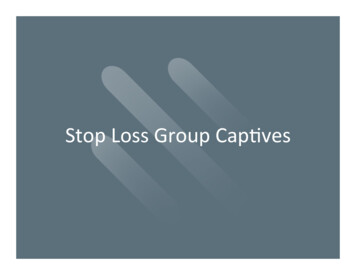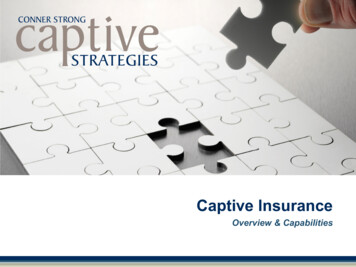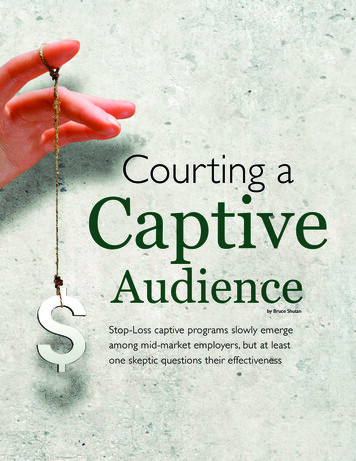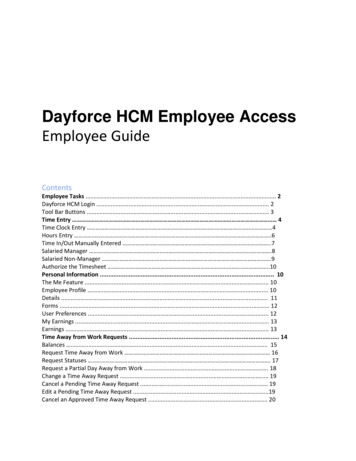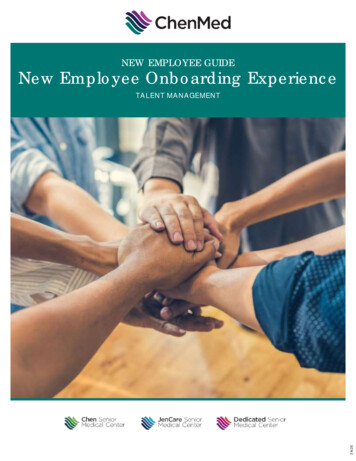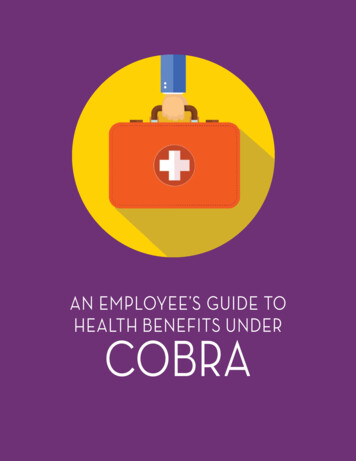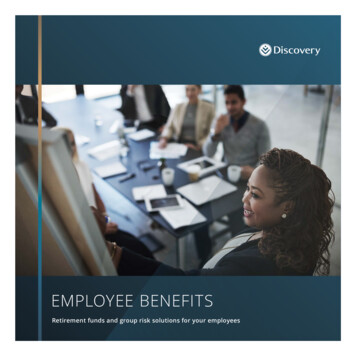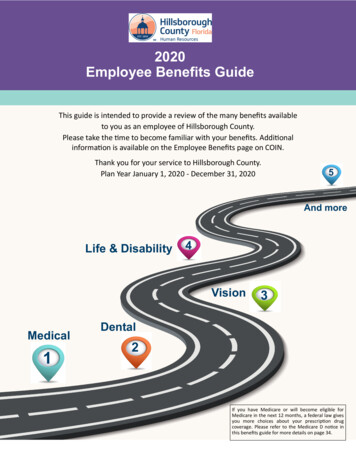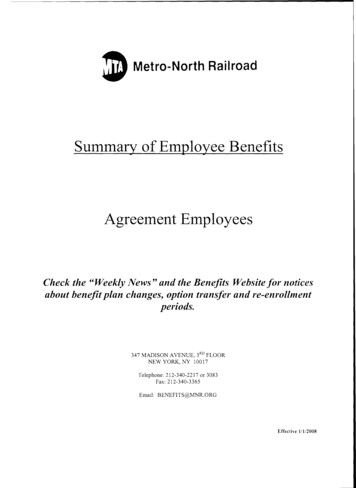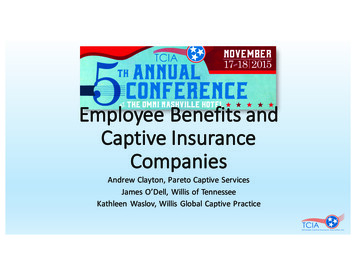
Transcription
Employee Benefits andCaptive InsuranceCompaniesAndrew Clayton, Pareto Captive ServicesJames O’Dell, Willis of TennesseeKathleen Waslov, Willis Global Captive PracticeTCIATennessee Captive Insurance Association, Inc.
Agenda 2Introduction to Employee Benefit Risk ExposuresCaptive Solutions for US Medical PlansCaptive Financing of US ERISA PlansPooling Global BenefitsFuture Outlook and ChallengesTCIATennessee Captive Insurance Association, Inc.
Employee Benefit Risk Exposures1. Large GlobalPlanUSMedicalUSLife, LTD14 Country PoolLife, MedicalDisabilityRest of World (est.)Global2. Mid-Market US3Lives25,0004,000USMedicalUSLife, irementPlanExposurePremiumSpend per EE 250 million 10,000 12.5 million 500 1.5 million 375 8.5 million 375LongevityLivesExposurePremiumSpend per EE200AccidentMorbidityMortality 1,000,000 5,000 60,000 300LongevityTCIATennessee Captive Insurance Association, Inc.
US Employee Benefit CostsPrivate Employer CostsWages & SalariesMandated Benefits (WC, SS,Medicare, Unemployment% / hour69.4% 21.828.0%Per EELife &DisabilityInsurance, 0.16 2.51Fringe Benefits4Healthcare7.7% 2.42 4,834Paid Leave6.9% 2.17 4,332Supplemental Pay3.5% 1.10 2,197Life & Disability Insurance0.5% 0.16 314Retirement4.0% 1.26 2,511TOTAL100% 31.42Retirement, 1.26Healthcare, 2.42Supplemental Pay , 1.10Paid Leave, 2.17EXAMPLE:200 employees 12 mm payrollw/ 1mm medical benefit paymentsTCIATennessee Captive Insurance Association, Inc.
Financing Employee Benefit Risk Deductible orSelf InsuredRetentionDeductible orSelf InsuredRetentionBy buying insurance for100% of the risk, the carrierreceives the full premium,but takes on the risks andpotential rewards of theinsured’s loss experience.5Instead of paying insurerprofits and expenseloads on the mostpredictable losses, theinsured takesresponsibility fordeductibles or SelfInsured t captivewith other risk types2.Cell captive with orwithout other employers3.Group captive withshared ownershipDeductible orSelf InsuredRetentionThe insured may preferto enhance control overthe claims managementand bear more risk,subject to enterprise’srisk appetite.Deductibles or Self InsuredRetentions may still beutilized, but the captiveaccepts risk up to moderatelevels of volatility andtransfers large losses to theexcess carriers.TCIATennessee Captive Insurance Association, Inc.
Stop Loss Group Captive aka Health Insurance Group Captive Provide employer access to self insurance without thetraditional risk and volatility Transparency Group purchasing dynamic Control over Underwriting Better experience rating6TCIA6Tennessee Captive Insurance Association, Inc.
Typical Captive Member Characteristics 7“Medium” sized employers – 50 to 400 enrolled ee’s80% come from Fully Insured programs20% come from Self Insured programs (this is new trend)Privately heldEntrepreneurialHave had “dammit” momentWant to control healthcare costsUnwilling to rely on “system”CONFIDENTIALTCIATennessee Captive Insurance Association, Inc.
Fully Insured Challenges 8Extra 3-6% of taxes compared to Self InsuredNo real/actionable dataReducing claims benefits carrier primarilyLimited control over plan designOnly looks good when viewing for one yearDoes not limit long-term riskCONFIDENTIALTCIATennessee Captive Insurance Association, Inc.
Self Insurance is Great but Bumpy 9Improves many of the Fully Insured flawsLasers can add significant increased costs/volatilityStop loss premiums can increase significantly in any given yearSpecific Limit levels under constant upward pressure“No Laser” policy only helps for a yearCONFIDENTIALTCIATennessee Captive Insurance Association, Inc.
Group Captive Structure - Administration Each member has their own TPA, plan, and stop loss policy Members’ terms are based on their experience Group decisions related to: Renewal / Service Providers Wellness Plan Designs & Options10TCIA 10Tennessee Captive Insurance Association, Inc.
Group Captive Structure – Risk Structure Each member has their own “small” self insured layer Members share mezzanine claims through the captive The captive buys catastrophic insurance (“stop loss”) for theunpredictable claims11TCIA 11Tennessee Captive Insurance Association, Inc.
Group Captive StructureRisk TransferGroup CaptiveAB C DEF G HIJIndividual Self Insured Retention (SIR) Layer12TCIATennessee Captive Insurance Association, Inc.
Group Captive StructureGroup captive provides the mechanism that reduces the year-to-yearvolatility and risk of being self-insured.13TCIATennessee Captive Insurance Association, Inc.
Basic Group Captive Structure Avoid MEWA (Multi-Employer Welfare Association) Association Health Plan Variation Captive Participant(s) Stop Loss & Reinsurance Limits Insured – employer, trust, affiliate Fronting Carrier and Reinsurance14TCIA 14Tennessee Captive Insurance Association, Inc.
Employer Motivations EB Market Frustration Transparency & Cost of Claims Renewal & Credibility Cost shifting Education Cash flow of claims Outcome based wellness Reactive vs Proactive15TCIA 15Tennessee Captive Insurance Association, Inc.
Employer Objections Status quo / inertia Too “risky” Too new More work Employee benefits are taboo16TCIA 16Tennessee Captive Insurance Association, Inc.
Captive Financing of US ERISA Plans ERISA-regulated Plans Medical, Pharmacy, Dental, and VisionLife Insurance/ Death in ServiceLong-term and Short-Term DisabilityTime off, Vacation, and Sick LeaveDefined-Benefit and Defined-Contribution Pension PlansRetiree Medical Non-ERISA Plans 17Most supplemental executive retirement plansOther plans offered to select groups of employees, such as expatriatesIndividual voluntary insurance, if not influenced by the employerEmployer-paid stop-loss insurance used to finance medical plans is not governed byERISA (see DOL Advisory Opinion 92-02A)TCIATennessee Captive Insurance Association, Inc.
ERISA PTE’s Captive insurance of ERISA plans is prohibited and requires a prohibitedtransaction exemption (PTE) from the US Department of Labor (DOL) if: The captive is a “party in interest” or majority-owned by the plan sponsor; and The insurance transaction involves “plan assets,” i.e., contributions by employees oremployers to fund the benefit plans The DOL will grant a PTE if proper application is made and certainconditions are satisfied There are 3 types of PTEs: Statutory: for insurance companies Class: for captives with 50% or more unrelated business Individual: for all other cases18TCIATennessee Captive Insurance Association, Inc.
Individual PTE’s The DOL has broad discretion in determining whether or not to grantexemptions. Approval is granted if the DOL determines that theexemption meets ERISA statutory criteria. It must be: Administratively feasible; In the interests of the plan, its participants, and its beneficiaries; and Protective of the rights of the plan's participants and beneficiaries. There are 2 paths to obtaining an individual PTE: EXPRO: an expedited process that takes 75-90 days, allowable if the application issubstantially similar to those already approved by the DOL Customized, based on individual facts and circumstances, for cases that have differentcharacteristics See DOL link: //www.dol.gov/ebsa/Regs/PTE procedures.html19TCIATennessee Captive Insurance Association, Inc.
EXPROEarly pioneers , Colombia Energy and ADM, proposed a set ofconditions for their captive reinsurance exemptions that have becomethe “substantially similar” standard for EXPRO approvals:US captive licenseAudited financial statementsUse of a fronting companyAn independent fiduciary who certifies that the transaction is in the bestinterests of employees A benefit improvement for the plan Typical cost has been less than a 1% increase However, the hurdle for improvements has increased since the first PTEs were issued in2000-200720 20TCIATennessee Captive Insurance Association, Inc.
Global Pooling and Captives Multinationals have used EB risk pooling solutions for 50 years, and usage hasbecome even more valuable to employers now, given these trends: Rapid growth in the cost and risk of offering employee benefits Employee demand for privately-funded benefits in growth economies Need for data to describe what benefits are offered locally, how much they cost, andwhat types of risks they pose Centralization of operations and governance to inform plan design decisions and rein incosts The interest in captive reinsurance of pools derives from: 21Better access to risk exposure and claims data for self-management of EB liabilitiesOpportunity to blend predictable EB risks with non-life risksPotential to reduce Solvency II capital requirements with diversified risk portfolioAccess to reinsurance market products for excess protection on a blended basisTCIATennessee Captive Insurance Association, Inc.
Prevalence and Usage2014 Usage Statistics*Network# EB Pools in Operation # EB Captives Insurope6470Maxis18221Swiss Life4351Zurich10010TOTAL2,89179 Most EB pools include these benefit risk exposures: Mortality (death benefits to survivors) Disability (income replacement) Accident (lump-sum benefits) Sickness (primary or supplementary medical anddrug payments) Some pools include risk-related elements ofretirement plans, such as survivor annuity benefits US benefits are rarely included Federal regulations prohibit profit-taking byemployers Some pools include medical stop loss whichreimburses employer payments* As reported by the Networks22TCIATennessee Captive Insurance Association, Inc.
Pools Transfer Risk And Drive Results Pools aggregate employee benefit liabilities and reduce the per-unit cost of benefit risk and relatedinsurance services. Pooling is designed for global companies who want to take a proactive approach to employee benefitfinancing and have the volume and scale to drive lower costs for their operating entities.Corporate ParentOperating EntitiesNetworkPartnersNetwork Pool123n Corporate Parent - sets global terms andOperating Entitiesconditions with one or more pooling networks.n Operating Entities - purchase local policiesand transfer risk to pooling Network Partners.n Networks - reinsure the premiums and risks,combine underwriting experience in the pools,and pay underwriting dividends to theCorporate Parent.NetworkPartnersNetwork Pool2TCIATennessee Captive Insurance Association, Inc.
Value of Pooling Information and Control Better understanding of risk exposures and claim trends Transparent pricing: claims expenses taxes riskcharges Coordinated, efficient communication via centralrelationships Service Level Agreements to enforce qualityperformanceIncreased risk retention can recover insurer marginsVolume from pooling can decrease per-unitexpenses Cost SavingsLong term, centralised focus can reduceclaims Reduced administrative expenses and riskcharges by 200 to 500 basis points Opportunity to recover underwriting marginsof 5% to 10% Local Benefits Secure, highly-rated local insurers No required changes to benefit plan designs Higher underwriting limits without medical esCaptiveRisk MarginTCIATennessee Captive Insurance Association, Inc.
Sample Captive Program StructureCaptive insurance program with multi-line reinsurance, cross-class aggregate protection, reinsurance market participation* Multi-line / Multi-year Insurance Program 1 - 3 years Blended captive retrocession protection for Propertyquota share, Liability, Financial or Special Lines, andLife EB** Cross Class Aggregate Stop Loss Additional captive protection For Non-life (P&C) and Life EmployeeBenefitsReinsurance MarketCapacityX/SX/SMulti Line / Multi-year eductiblesDeductibles DeductiblesPropertyFinancial orLife EBSpecial Lines(Cyber, EIL,etc.)X/SZURICHML / MY *Cross ClassAggregatePrimaryStop Loss **Diagram from Zurich, July 2015TCIATennessee Captive Insurance Association, Inc.
Emerging Trends and IssuesCompetition among the 8 pooling networksMore global data available, especially medical claimsBetter systems and reportingRisk analytics to measure exposure, spot trends, and optimize risk retentionand risk transfer Focus on minimizing premium rather than maximizing dividends Use of Captives 26TCIATennessee Captive Insurance Association, Inc.
Practice & ValueWhere does one start? Clearly depends on the client, but always with the HR team! HR teams are the owners of the EB risksRisk Managers are the experts for insurance solutionsAppropriation of the HR language, regulations is key for the Risk ManagerAppropriation of the risk optimization solutions is key for the HR Manager Value to both HR and RM Managing data and risks to prevent and lessen losses Local HR advantages include increased flexibility with regards to underwriting, e.g.nuclear, chemical & biological events coverage, high risk sports, ex-gratia payments RM advantages include risk-capital optimization by reduction in capital requirementvia risk diversification27TCIATennessee Captive Insurance Association, Inc.
Andrew Clayton, Pareto Captive Services James O’Dell, Willis of Tennessee Kathleen Waslov, Willis Global Captive Practice. TCIA Tennessee Captive Insurance Association, Inc. Agenda Introduction to Employee Benefit Risk Exposures
